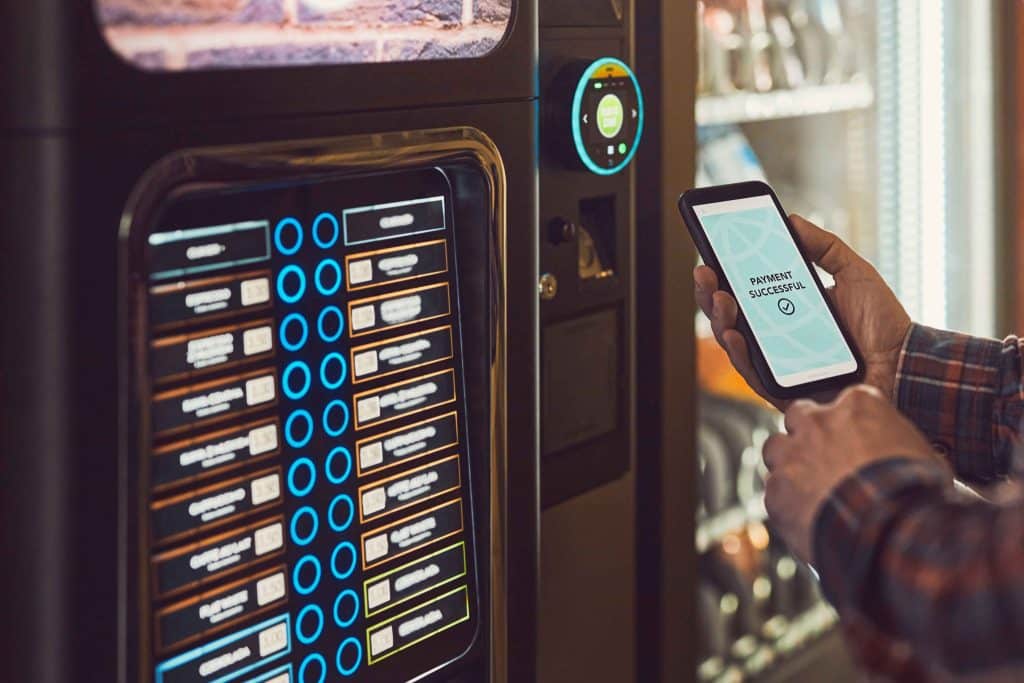Integrating Digital Vending Software With Other Business Systems
As businesses increasingly embrace digitalization, the integration of digital vending software with other business systems has become a crucial step towards achieving operational efficiency and a seamless customer experience.
This process involves the incorporation of digital vending machine software into the broader IT infrastructure, facilitating real-time data exchange and analytics, inventory management, and sales tracking.
Despite the potential challenges, successful integration can lead to significant benefits including cost savings, improved productivity, and enhanced customer satisfaction.
This blog aims to explore the strategies, challenges, and future trends of integrating digital vending software with other business systems.
Read more about our Smart Vending Solutions!
Key Takeaways
- Integrating digital vending software with inventory management systems allows for real-time inventory tracking, improved forecasting, operational efficiency, streamlined operations, and enhanced service delivery.
- Integration with payment and POS systems enhances transactional efficiency, real-time tracking, reduced errors, improved decision making, and a seamless customer experience.
- Smart vending machines contribute to the customer experience, operational efficiency, cost savings, data-driven insights, convenience, personalization, instant gratification, and customer satisfaction.
- The evolution from traditional vending machines to digital vending machines has resulted in features such as digital screens, interactive interfaces, support for various payment methods, real-time inventory tracking, sales monitoring, and integration with other business systems for comprehensive data analytics.
The Evolution of Vending Technology: From Traditional to Digital
The landscape of vending technology has radically transformed over the years, shifting from traditional mechanisms to a more digital format. This progression has led to the proliferation of intelligent vending machines equipped with advanced features and capabilities.
To fully appreciate this shift, we will compare the aspects of traditional vending machines with their more advanced, digital counterparts.
The Rise of Digital Vending Machines
In the realm of vending technology, a significant shift from traditional mechanisms to digital vending machines is clearly evident. This evolution has seen the emergence of intelligent vending machines and kiosk vending machines. The market is replete with smart vending machines for sale, signaling a growing demand for this advanced technology.
| TRADITIONAL VENDING | PRODUCT PERFORMANCE | STRATEGIC DECISION |
| Mechanical operation | Digital interface | AI and IoT integration |
| Limited product range | Wide product diversity | Customizable product range |
| Predominantly cash-based | Cashless transactions | Contactless and mobile payments |
The rise of the digital vending machine and smart vending machine is a testament to the fusion of convenience and technology. Whether it’s a digital vending machine for sale or a smart vending machine for sale, the future of vending lies in digital transformation.
Features and Capabilities of Smart Vending Machines
Leveraging advanced technology, smart vending machines incorporate a plethora of features and capabilities that mark a significant evolution from traditional vending mechanisms. These machines utilize digital screens, interactive user interfaces, and personalized customer engagement strategies to deliver an enhanced user experience.
They support a variety of payment methods, including credit/debit cards, mobile payments, and even cryptocurrencies, thereby providing a seamless transaction process. Advanced telemetry allows real-time inventory tracking, sales monitoring and predictive analytics for efficient stock management. Some models are also equipped with facial recognition technology for personalized advertising and age-verification for restricted products.
Furthermore, integration with other business systems such as ERP or CRM provides comprehensive data analytics, leading to actionable insights for business growth.
Comparing Traditional and Intelligent Vending Machines
Over the past few decades, vending technology has undergone a substantial transformation. It has shifted from traditional, coin-operated machines to digital, intelligent systems with a myriad of advanced features.
Traditional vending machines were limited in functionality. They only accepted coins or bills and dispensed a narrow range of products. However, the evolution to intelligent machines has unlocked a plethora of capabilities.
These machines accept digital payments, offer a wider array of goods, provide real-time inventory tracking, and even personalized user experiences using AI and data analytics.
This evolution has not only expanded the utility of vending machines but also enhanced their operational efficiency. This makes them invaluable assets in today’s fast-paced business environment.
The Business Case for Digital Vending Machines
The transition to digital vending machines presents compelling business advantages that can be categorized into three main areas: enhancing customer experience through smart technology, bolstering operational efficiency and cost savings, and leveraging data-driven insights for strategic decision-making.
Utilizing smart technology not only modernizes the customer experience but also provides a platform for interactive consumer engagement.
Operational efficiency gains and cost savings occur through streamlined processes, while data collection capabilities allow companies to make informed, strategic decisions.

Enhancing Customer Experience with Smart Technology
In today’s rapidly evolving digital landscape, smart technology integrated into digital vending machines significantly enhances the customer experience by offering convenience, personalization and instant gratification.
- Convenience: Digital vending machines, with their 24/7 availability, eliminate the need for human interaction, making purchases easy and quick.
- Personalization: Advanced AI algorithms can track customer preferences, allowing for personalized product recommendations, thereby enhancing the customer relationship.
- Instant Gratification: The instant provision of products and services fulfills the customer’s immediate needs, contributing to customer satisfaction and loyalty.
These factors underscore the business case for digital vending machines, demonstrating their potential to revolutionize the vending industry and significantly improve the customer experience.
Operational Efficiency and Cost Savings
With a focus on operational efficiency and cost savings, digital vending machines present a compelling business case by dramatically reducing overheads and streamlining business processes. These intelligent machines leverage advanced technology to automate inventory management, therefore eliminating the need for manual stock-checking and replenishment.
This results in significant time and labor savings, reducing operational costs. The use of real-time data analytics also enables optimal product placement and stock adjustment based on consumer buying patterns that maximize sales and revenues.
Moreover, the ability to integrate with other business systems facilitates consolidated reporting and better decision making.
Digital vending machines not only enhance customer experience but also deliver substantial operational efficiency and cost savings, making them an attractive investment for businesses.
Data-Driven Insights for Strategic Decision Making
Harnessing the power of data, digital vending machines provide invaluable insights that can guide strategic decision-making in businesses. These data-driven machines allow businesses to optimize their operations, improve customer satisfaction, and increase profitability.
- Optimize Operations: The data collected by digital vending machines can help identify peak sales times, most popular products, and inventory turnover rates, enabling businesses to adjust their operations accordingly.
- Improve Customer Satisfaction: By analyzing purchase patterns and customer behavior, businesses can tailor their product offerings to meet customer preferences, thereby improving customer satisfaction and loyalty.
- Increase Profitability: With enhanced operational efficiency and customer satisfaction, businesses can realize higher sales and profitability. These data insights provide a powerful tool for strategic decision-making, thus making a compelling business case for digital vending machines.
Integrating Digital Vending Machines with Business Systems
The integration of digital vending machines with existing business systems is critical for seamless operations and improved service delivery.
This can be achieved through connections to inventory management systems, integration with payment and POS systems, and leveraging data analytics.
In the following sections, we will explore each of these key integration points in more detail.
Connecting to Inventory Management Systems
How can the integration of digital vending software with inventory management systems streamline business operations and drive profitability?
This integration can indeed be a game-changer for businesses, primarily through three mechanisms:
- Real-time Inventory Tracking: Integration allows for automatic updates on stock levels, reducing the chances of stock-outs or overstocking, thus optimizing inventory costs.
- Improved Forecasting: With the ability to track sales and inventory in real-time, businesses can better predict future demand, helping with procurement and production planning.
- Operational Efficiency: A unified system reduces manual tasks like data entry and report generation, saving time and reducing errors.
These benefits not only streamline operations but also provide valuable data insights, enhancing decision-making and ultimately driving profitability.
Ready to transform your business with cutting-edge Digital Vending Software?
Integration with Payment and POS Systems
Integrating digital vending software with payment and Point of Sale (POS) systems can significantly enhance transactional efficiency and accuracy, providing a seamless purchasing experience for customers. This integration allows for real-time tracking of sales and inventory, which in turn aids in better decision-making and improved business operations. This pairing also facilitates automatic updates, eliminating the need for manual entry, thereby reducing the chances of error.
Consider the following table:
| BENEFITS | PAYMENT SYSTEMS | POS SYSTEMS |
| Enhanced Transactional Efficiency | Speedy checkouts | Accurate sales tracking |
| Real-time Tracking | Immediate payment confirmation | Live inventory updates |
| Reduced Errors | Automated data entry | Elimination of manual updates |
| Improved Decision Making | Financial insights | Stock management |
| Seamless Customer Experience | Easy payment options | Quick service |
The successful integration of digital vending software with payment and POS systems is a game-changer in the vending industry.
Leveraging Data Analytics for Improved Service Delivery
Building on the integration of digital vending software with payment and POS systems, leveraging data analytics can further improve service delivery by providing valuable insights into customer behavior and market trends.
- Customer Behavior Analysis: Data analytics can help understand customer buying patterns and preferences. This data can be used to stock products efficiently, promoting customer satisfaction and repeat business.
- Market Trend Forecasting: By analyzing industry trends and market data, businesses can anticipate future demands, enabling them to plan and adjust their product offerings accordingly.
- Service Delivery Optimization: Data analytics can identify bottlenecks and inefficiencies in the service delivery process. By addressing these issues, businesses can significantly improve customer experience, enhance operational efficiency, and increase profitability.
Challenges and Solutions in Integration
While digital vending software integration offers numerous benefits, it also presents certain challenges that need to be addressed effectively to maximize the potential of the integrated systems.
- Overcoming technical hurdles: Integrating different software systems can be complex and may require overcoming technical challenges such as compatibility issues, data synchronization, and ensuring seamless communication between different components of the integrated system.
- Ensuring security and privacy: With the integration of different software systems, there is an increased risk of security breaches and privacy concerns. It is crucial to implement robust security measures, such as encryption and authentication protocols, to protect sensitive data and ensure the privacy of users.
- Achieving seamless user experiences across platforms: When integrating software systems, it is important to ensure a consistent and seamless user experience across different platforms, such as mobile devices, web browsers, and kiosks. This requires careful attention to user interface design, usability testing, and responsive design principles.

To address these challenges, businesses can consider the following potential solutions for successful integration:
- Conduct thorough compatibility testing and resolve any technical issues before implementing the integration.
- Implement strong security measures, such as encryption, firewalls, and intrusion detection systems, to safeguard the integrated systems and protect user data.
- Engage in regular security audits and vulnerability assessments to identify and address any potential security risks.
- Prioritize user experience by designing intuitive interfaces, optimizing performance, and conducting usability testing across different platforms.
- Provide comprehensive training and support for users to ensure they can effectively navigate and utilize the integrated systems.
Overcoming Technical Hurdles
The process of integrating digital vending software with other business systems often presents a series of technical hurdles that require careful navigation and strategic problem-solving. It’s essential to identify and confront these challenges head-on to ensure seamless integration.
- Incompatible Systems: Different systems may use different data formats, making integration difficult. Solutions may include using middleware or adopting a common data format.
- Data Integrity: Ensuring the accuracy and consistency of data can be challenging. Regular data audits, validation rules, and error detection algorithms can help maintain data integrity.
- Security Concerns: Integration can expose systems to potential security risks. To mitigate this, robust security measures such as encryption, user authentication, and regular security tests should be implemented.
Ensuring Security and Privacy
In the realm of system integration, security and privacy stand as paramount concerns, requiring meticulous attention and strategic solutions to ensure data protection.
The integration process opens up new avenues for data breaches, posing a significant challenge. Unauthorized access, data leakage, and intrusion are among the risks that must be mitigated. To overcome these challenges, businesses can employ robust encryption methods, implement stringent access control measures, and regularly conduct vulnerability assessments.
Moreover, adopting privacy-by-design principles in system integration can further protect user data. This involves incorporating privacy controls into the design and architecture of the system, rather than as an afterthought.
Achieving Seamless User Experiences Across Platforms
Navigating through the integration of digital vending software with other business systems, achieving seamless user experiences across different platforms emerges as a critical challenge, demanding innovative solutions for successful implementation.
In pursuit of this, businesses face several obstacles.
- Interoperability: Different systems often use disparate technologies, making integration complex and potentially disruptive to operations.
- Data Consistency: Ensuring data integrity and consistency across platforms is another hurdle. Misaligned data can negatively impact user experience and decision-making processes.
- Security: With integration, the risk of data breaches increases. Robust security measures must be in place to protect sensitive information.
Solutions include adopting standard protocols, implementing robust data validation processes, and prioritizing cybersecurity. By overcoming these challenges, businesses can provide a seamless experience to users.
Future Trends in Digital Vending and Business Integration
Looking ahead, it is clear that the future of digital vending and business integration lies in the hands of emerging technologies.
Artificial Intelligence (AI) and Machine Learning are poised to play pivotal roles in enhancing the efficiency of digital vending systems.
Moreover, the advent of Internet of Things (IoT)-enabled smart vending machines and the imminent impact of 5G on vending machine connectivity are set to revolutionize the sector.

The Role of AI and Machine Learning
Increasingly, artificial intelligence and machine learning are becoming pivotal in shaping the future trends of digital vending and business integration. These technologies are driving innovations that enhance efficiency, personalize customer experiences, and optimize inventory management.
- Efficiency Enhancement: AI can automate several business processes, reducing human error and increasing productivity. For instance, smart vending machines can automatically process transactions and restock inventory.
- Personalized Customer Experiences: Machine learning algorithms can analyze customer data to predict purchasing preferences, enabling businesses to tailor their offerings to individual consumers.
- Optimized Inventory Management: AI can predict inventory needs based on historical sales data, allowing businesses to avoid stockouts and overstocking, thereby maximizing profits.
IoT-Enabled Smart Vending Machines for Sale
Frequently, the integration of IoT-enabled smart vending machines is emerging as a promising future trend in digital vending and business integration. These machines facilitate real-time inventory management, predictive maintenance, and dynamic pricing strategies, all of which bolster operational efficiency and customer satisfaction.
| IOT-ENABLED SMART VENDING TRENDS | IMPACT ON BUSINESS | FUTURE PROJECTION |
| Real-time Inventory Management | Streamlined Operations | Widespread Adoption |
| Predictive Maintenance | Reduced Downtime | Increased Efficiency |
| Dynamic Pricing Strategies | Enhanced Profitability | Progressive Growth |
| Dynamic Pricing Strategies | Enhanced Profitability | Progressive Growth |
| Dynamic Pricing Strategies | Enhanced Profitability | Progressive Growth |
With the continuous advancement in technology, the potential for these smart machines in revolutionizing the vending industry is substantial, marking the dawn of a new era in digital vending and business integration.
The Impact of 5G on Vending Machine Connectivity
The advent of 5G technology promises to substantially alter the landscape of vending machine connectivity, heralding an array of future trends in digital vending and business integration.
- Increased Speed and Efficiency: With 5G, vending machines will operate at unprecedented speeds, enabling real-time data collection and processing. This will increase efficiency in inventory management, sales tracking, and customer engagement.
- Enhanced Customer Experience: Through high-speed connectivity, vending machines can offer personalized and interactive user experiences, strengthening customer relations and boosting sales.
- Seamless Integration: The 5G technology will allow vending machines to seamlessly connect and integrate with other business systems, facilitating data sharing and analysis, and ultimately leading to informed business decisions and strategies.
Conclusion
In the era of digital transformation, the integration of digital vending software with business systems emerges as an innovative strategy, despite challenges. This fusion not only enhances operational efficiency but also boosts customer satisfaction.
As the realm of digital vending continues to evolve, businesses must adapt to keep pace with technological advancements. Hence, the synergy of digital vending machines and business systems represents a promising frontier in the ongoing quest to optimize business operations.
Frequently Asked Questions
What Are Some Popular Digital Vending Software Options Available in the Market?
Several digital vending software options are popular in the market, including Primi Digital’s Vendi360.
How Are Refunds and Returns Generally Handled by Digital Vending Software?
Although concerns may arise regarding refunds and returns, digital vending software typically facilitates these processes effectively. This includes automated return authorizations, tracking, and processing, ensuring a seamless experience for customers and businesses alike.
How Does the Maintenance of Digital Vending Machines Compare to Traditional Vending Machines?
Digital vending machine maintenance, compared to traditional machines, is often more streamlined and efficient due to automated system diagnostics, remote troubleshooting, and real-time inventory tracking, thus reducing downtime and improving overall operational efficiency.
Can Digital Vending Machines Be Customized to Match the Branding of the Business?
Absolutely, digital vending machines can be tailored to echo the unique branding of a business. This encompasses color schemes, logos, and even promotional content, creating a cohesive visual experience for customers.
Are There Any Training Resources Available for Businesses Transitioning to Digital Vending Machines From Traditional Ones?
Yes, many digital vending machine providers offer comprehensive training resources. These can range from user manuals, online tutorials, to hands-on training sessions to assist businesses during their transition from traditional vending machines.
